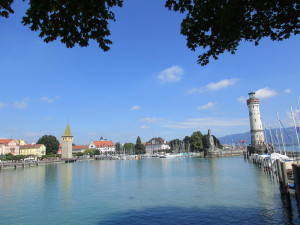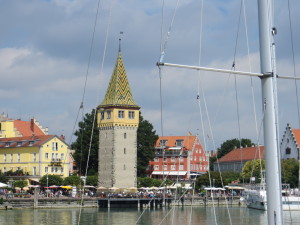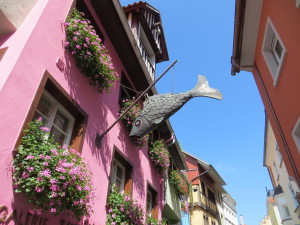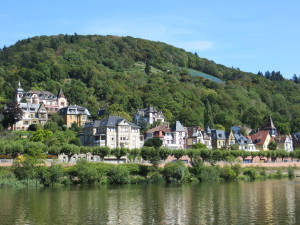In the southwestern corner of Germany, there is a freshwater lake that borders three countries: Germany, Austria and Switzerland. Lake Constance is the international name given at the conclusion of the 15th-Century Council of Constance. But in Germany the lake is called Bodensee (literally, land-lake) after the nearby town of Bodman. The most fascinating aspect of the lake is that it is the only portion of Europe with no official borders, because the Germans, Austrians and Swiss can’t agree on exactly where the borders should be.
The town of Lindau, which is definitely in Germany, sits on a small island that juts out into the lake near its northeastern shore. Lindau dates back to Roman times, when it was a fishing village. Nowadays it’s a popular summer destination for Germans and other Europeans. Everyone who does business on the island speaks English, just like everywhere else in the free world where tourism is king. But not many English-speaking tourists actually visit the place – some Brits, and a handful of Americans and Canadians.
But as luck would have it, on our first evening in Lindau we happened to sit down for dinner next to an American couple, and we struck up a conversation. She’s a physician, he works in the pharmaceutical industry, and her daughter recently graduated from MICA (the prestigious art institute in Baltimore). Small world, right? They’re living in Germany while he’s on assignment for Novartis, and they discovered Lindau on the way home from skiing in Switzerland. They wanted to know how we heard about the place.
The answer was a little too complicated for a brief conversation across dinner tables. But simply put, we were looking for somewhere interesting to stay near Lochau. You remember Lochau, right? That’s the small town in upper Bavaria where George’s great-great-great grandfather Peter Herold was born. But prior to the trip George was under the impression that Peter Herold’s Lochau was a different small town, one that lies in Austria near the German border, just minutes from Lindau by car.
Fortunately, George got an email from his cousin John Herold the evening before we left Dresden for Munich. John, who is also a descendent of Peter Herold, had done some additional research and determined that the correct Lochau was in Bavaria, not Austria. The timing was perfect, since the Lochau we wanted was on our way to Munich. John’s email saved us from driving around Austria like a couple of idiots, looking for traces of someone who probably never even set foot in that country. It also meant our time in Lindau was completely unstructured. Which turned out to be great, because Lindau is a really nice place to meander around for a couple of days.
Lindau reminded us of the island of Guernsey in the English Channel. It has a beautiful waterfront lined with cafés and hotels. Its winding cobblestone streets are full of local shops and what seemed like a thousand ice cream vendors. The lakefront features a medieval seawall with a retired lighthouse that dates back to the 12th Century and a newer one that’s still almost 200 years old. You can climb the narrow, twisting steps to the top and take in spectacular views of the Alps rising in the distance beyond the lake. It only takes a few hours to walk the entire island, and we were fortunate to have great weather for doing so. And since we didn’t need to drive to Austria in search of Peter Herold, well, we didn’t. (Sorry, Austria. Some other time.) Instead we just relaxed, admired the beautiful scenery, and enjoyed great food and wine.
Our final destination of the trip was Heidelberg, another town with no ancestral ties or special agenda. But in this case there was no mistake on our map either. We definitely chose the right Heidelberg. It’s one of Germany’s best-preserved cities, having avoided significant damage during WWII. And it’s only an hour from the Frankfurt airport, where we would come full circle to finish the journey.
On the way to Heidelberg we made one last pit stop in Stuttgart. The city itself isn’t much to see, but it’s home to two famous car museums, one by Mercedes-Benz and the other by Porsche. We only had time for one, so we went with Mercedes-Benz. Of the two museums it’s the more historical, since Gottlieb Daimler and Karl Benz are co-credited with the invention of the automobile. (At least they are in Germany. But depending on exactly what you mean by the words “invention” and “automobile” there are several other persons of non-German heritage who also get some of the credit.)
I visited this same museum 25 years ago. Back then it was housed in a relatively unremarkable building. But in 2006 the Daimler AG company opened a sprawling, modern complex with an exterior shaped like a coil (or cloverleaf) intended to resemble an early type of engine. Inside the building are some great old cars and plenty of history. Interestingly, though Daimler and Benz lived just 50 miles apart, met briefly, and were well aware of each other’s accomplishments, they never got to know one another and their companies didn’t merge until 1926, when Germany’s economy was in a shambles and neither enterprise could make it on its own anymore.
As for Heidelberg, it’s mainly a college town. In fact the university there is Germany’s oldest, founded in 1386. And it’s because of the university, which has attracted international students for centuries, that the Allies were reluctant to bomb Heidelberg during the war. Or so the theory goes, though it’s never been verified. In any case, the main tourist attractions are some beautiful old churches and bridges and buildings scattered around yet another baroque-era town full of cobblestone streets and modern-day shops. Up in the hills, hovering over the town, lay the ruins of a castle (or Schloss, if you’re speaking German) that dates back, at least in part, to the 13th Century. But you can’t blame Allied bombs for this particularly lovely pile of rubble. Armies of the Holy Roman Empire were the culprits, mostly during the Thirty Years War. Best of all for George, the Schloss has a museum of pharmacy!
Driving out of Heidelberg, we managed to get slightly lost, but it was Google maps to the rescue again, and then we were on our way to the Frankfort airport’s rental car return with heavy hearts but happy memories. Three weeks isn’t nearly enough time to see a whole country like Germany, of course, but after 3053 kilometers (1832 miles) and six tanks of expensive petrol, we think we got a pretty good feel for the place. Are more of George’s ancestors lurking in other tiny burgs? No doubt. And not only in Germany, but England and Ireland too. Eventually we might even end up driving around central Africa, because George is well on his way to tracing his roots back to Lucy.
No, we won’t really drive around central Africa. We’re adventurous, not morons.
So back to Baltimore we go. Back to ordinary reality, which always feels a bit meh after one of these trips. But at least we’ll also be back to being fluent in the local language, and having no trouble finding skim milk and green vegetables.
Until next time! (Or as our German friends might say, bis dann!)


























